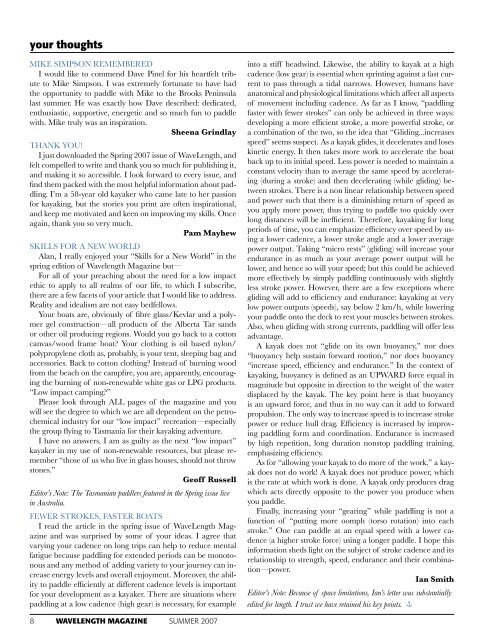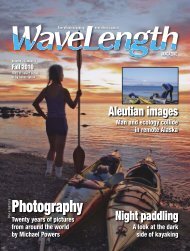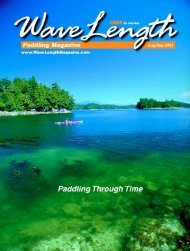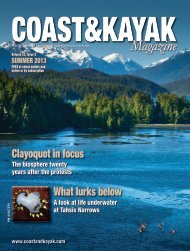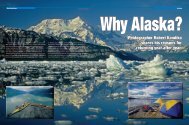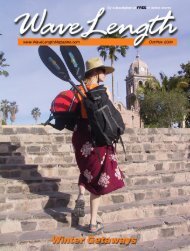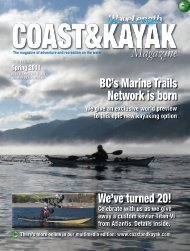download - Wavelength Paddling Magazine
download - Wavelength Paddling Magazine
download - Wavelength Paddling Magazine
Create successful ePaper yourself
Turn your PDF publications into a flip-book with our unique Google optimized e-Paper software.
your thoughts<br />
MIKE SIMPSON REMEMBERED<br />
I would like to commend Dave Pinel for his heartfelt tribute<br />
to Mike Simpson. I was extremely fortunate to have had<br />
the opportunity to paddle with Mike to the Brooks Peninsula<br />
last summer. He was exactly how Dave described: dedicated,<br />
enthusiastic, supportive, energetic and so much fun to paddle<br />
with. Mike truly was an inspiration.<br />
Sheena Grindlay<br />
THANK YOU!<br />
I just <strong>download</strong>ed the Spring 2007 issue of WaveLength, and<br />
felt compelled to write and thank you so much for publishing it,<br />
and making it so accessible. I look forward to every issue, and<br />
find them packed with the most helpful information about paddling.<br />
I’m a 58-year old kayaker who came late to her passion<br />
for kayaking, but the stories you print are often inspirational,<br />
and keep me motivated and keen on improving my skills. Once<br />
again, thank you so very much.<br />
Pam Mayhew<br />
SKILLS FOR A NEW WORLD<br />
Alan, I really enjoyed your “Skills for a New World” in the<br />
spring edition of <strong>Wavelength</strong> <strong>Magazine</strong> but—<br />
For all of your preaching about the need for a low impact<br />
ethic to apply to all realms of our life, to which I subscribe,<br />
there are a few facets of your article that I would like to address.<br />
Reality and idealism are not easy bedfellows.<br />
Your boats are, obviously of fibre glass/Kevlar and a polymer<br />
gel construction—all products of the Alberta Tar sands<br />
or other oil producing regions. Would you go back to a cotton<br />
canvas/wood frame boat? Your clothing is oil based nylon/<br />
polypropylene cloth as, probably, is your tent, sleeping bag and<br />
accessories. Back to cotton clothing? Instead of burning wood<br />
from the beach on the campfire, you are, apparently, encouraging<br />
the burning of non-renewable white gas or LPG products.<br />
“Low impact camping?”<br />
Please look through ALL pages of the magazine and you<br />
will see the degree to which we are all dependent on the petrochemical<br />
industry for our “low impact” recreation—especially<br />
the group flying to Tasmania for their kayaking adventure.<br />
I have no answers, I am as guilty as the next “low impact”<br />
kayaker in my use of non-renewable resources, but please remember<br />
“those of us who live in glass houses, should not throw<br />
stones.”<br />
Geoff Russell<br />
Editor’s Note: The Tasmanian paddlers featured in the Spring issue live<br />
in Australia.<br />
FEWER STROKES, FASTER BOATS<br />
I read the article in the spring issue of WaveLength <strong>Magazine</strong><br />
and was surprised by some of your ideas. I agree that<br />
varying your cadence on long trips can help to reduce mental<br />
fatigue because paddling for extended periods can be monotonous<br />
and any method of adding variety to your journey can increase<br />
energy levels and overall enjoyment. Moreover, the ability<br />
to paddle efficiently at different cadence levels is important<br />
for your development as a kayaker. There are situations where<br />
paddling at a low cadence (high gear) is necessary, for example<br />
into a stiff headwind. Likewise, the ability to kayak at a high<br />
cadence (low gear) is essential when sprinting against a fast current<br />
to pass through a tidal narrows. However, humans have<br />
anatomical and physiological limitations which affect all aspects<br />
of movement including cadence. As far as I know, “paddling<br />
faster with fewer strokes” can only be achieved in three ways:<br />
developing a more efficient stroke, a more powerful stroke, or<br />
a combination of the two, so the idea that “Gliding...increases<br />
speed” seems suspect. As a kayak glides, it decelerates and loses<br />
kinetic energy. It then takes more work to accelerate the boat<br />
back up to its initial speed. Less power is needed to maintain a<br />
constant velocity than to average the same speed by accelerating<br />
(during a stroke) and then decelerating (while gliding) between<br />
strokes. There is a non linear relationship between speed<br />
and power such that there is a diminishing return of speed as<br />
you apply more power, thus trying to paddle too quickly over<br />
long distances will be inefficient. Therefore, kayaking for long<br />
periods of time, you can emphasize efficiency over speed by using<br />
a lower cadence, a lower stroke angle and a lower average<br />
power output. Taking “micro rests” (gliding) will increase your<br />
endurance in as much as your average power output will be<br />
lower, and hence so will your speed; but this could be achieved<br />
more effectively by simply paddling continuously with slightly<br />
less stroke power. However, there are a few exceptions where<br />
gliding will add to efficiency and endurance: kayaking at very<br />
low power outputs (speeds), say below 2 km/h, while lowering<br />
your paddle onto the deck to rest your muscles between strokes.<br />
Also, when gliding with strong currents, paddling will offer less<br />
advantage.<br />
A kayak does not “glide on its own buoyancy,” nor does<br />
“buoyancy help sustain forward motion,” nor does buoyancy<br />
“increase speed, efficiency and endurance.” In the context of<br />
kayaking, buoyancy is defined as an UPWARD force equal in<br />
magnitude but opposite in direction to the weight of the water<br />
displaced by the kayak. The key point here is that buoyancy<br />
is an upward force, and thus in no way can it add to forward<br />
propulsion. The only way to increase speed is to increase stroke<br />
power or reduce hull drag. Efficiency is increased by improving<br />
paddling form and coordination. Endurance is increased<br />
by high repetition, long duration nonstop paddling training,<br />
emphasizing efficiency.<br />
As for “allowing your kayak to do more of the work,” a kayak<br />
does not do work! A kayak does not produce power, which<br />
is the rate at which work is done. A kayak only produces drag<br />
which acts directly opposite to the power you produce when<br />
you paddle.<br />
Finally, increasing your “gearing” while paddling is not a<br />
function of “putting more oomph (torso rotation) into each<br />
stroke.” One can paddle at an equal speed with a lower cadence<br />
(a higher stroke force) using a longer paddle. I hope this<br />
information sheds light on the subject of stroke cadence and its<br />
relationship to strength, speed, endurance and their combination—power.<br />
Ian Smith<br />
Editor’s Note: Because of space limitations, Ian’s letter was substantially<br />
edited for length. I trust we have retained his key points. <br />
8 WAVELENGTH MAGAZINE SUMMER 2007


